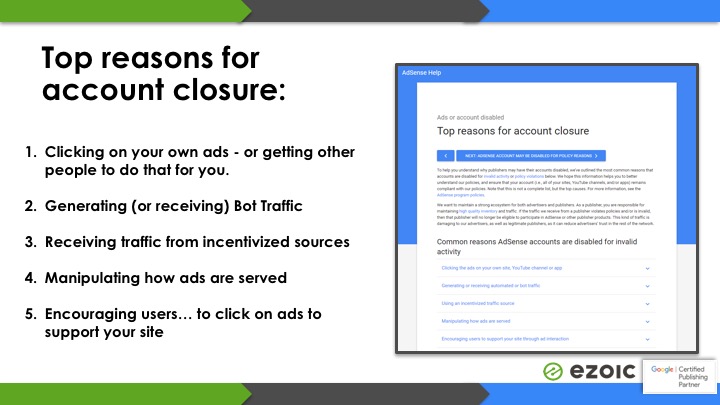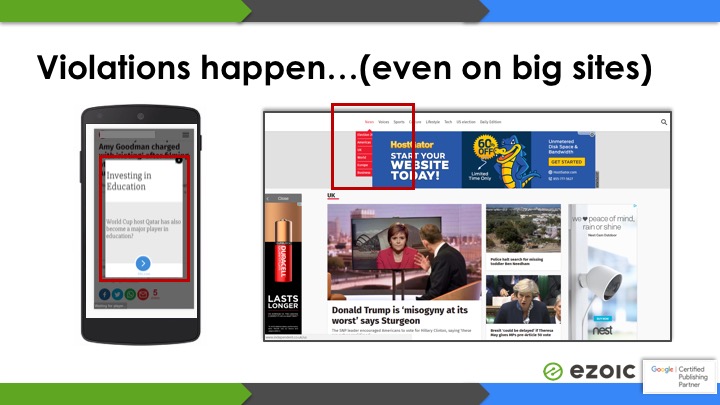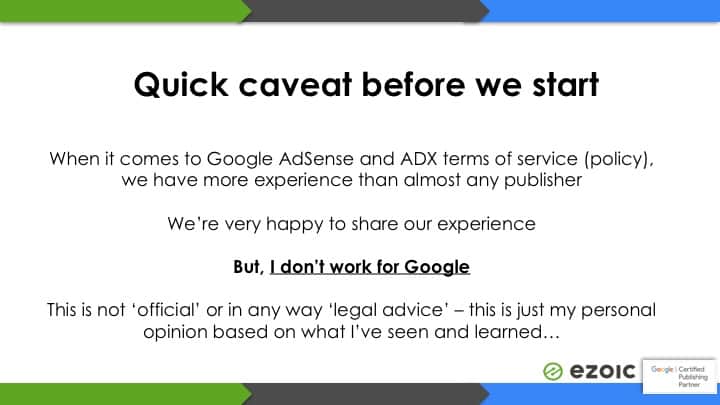How Does Google Really Enforce AdSense Policy?
Now, I know that Google AdSense policy is not the most entertaining or exciting subject on the planet. However, it is dramatically important for online publishers who use AdSense and collect regular revenue from the service.

The internet is filled with site owners who have been banned for AdSense policy violations — many of them without understanding why. This is why we felt it was so important to lay out a guide to how Google typically enforces its AdSense policy.
Below, you will see real-world examples of things that will get you flagged, things you can get away with, and AdSense policy violations that will — 100% of the time — get you banned.

Quick disclaimer, I don’t work for Google. I’m an executive for a Google Certified Publishing Partner. I have seen thousands of these cases, but am not speaking on behalf of Google here. In fact, quite the opposite. This is not official or legal advice. I think you get it.
If you’d rather watch this Google Policy overview, you can see the whole thing here.
Common AdSense Policy Violations
So, I’m going to start by outlining 6 common Adsense policy violations that we see publishers get all the time. These are the things you should avoid at all costs. They may not get you banned outright, but if you keep getting alerts about these, you certainly will.
Don’t ignore these alerts!

Here’s why you are getting these — or other penalties — and what you can do to fix the problems associated with each one. In my experience, these are almost always justified. They do have the ability to get you banned eventually and may or may not be happening with you actively knowing you are violating Google policy.
The loss of “nessie ads”
These are those nice little text ads with arrows attached to them on your site. These perform well and are good ads to have. If Google sees you using these deceptively — i.e. too close to navigation, next buttons, etc. they will take these ads away from you. This is a baby step towards banning (which we will dig in to a little deeper below).

No 250 x 300 above the fold on mobile
This is something a lot of publishers don’t know about. This is something you may get away with for a while, but you could rack up AdSense policy violations pretty quickly if you are actively running these now.
There is a simple solution to this. If you want an ad here, don’t show a Google ad. Show another type of ad if you think this is a top earner. We think the best thing to do is test which ads are effective (i.e. the ones that earn the most without causing people to bounce).

You might be saying to yourself, “wait a minute, I see defaultpopularwebsite.com doing this all the time”. And, you might be right.
Those publishers are in violation and will be dealt with by Google eventually, but Google is much more likely to give leeway to larger more well-established sites. Don’t take your chances.
 Not more than 1 ad above the fold on a mobile viewport
Not more than 1 ad above the fold on a mobile viewport
This is another violation that a lot of publishers aren’t aware of; or are in current AdSense policy violation of. Many set their ads on desktop and don’t realize how these ads are truly displaying on mobile. This is one of the most common violations we see.
Avoid putting ads over content
This isn’t a common thing publishers are flagged for unless the violation is obscene; however, it can happen. Many publishers have layouts that cause this or ads that are sized incorrectly. Nevertheless, if it is happening on your site it is smart to fix it.

Thin content can get you in trouble pretty fast
Thin content is something you can get flagged for; however, it is not a Google AdSense policy violation that is going to get you banned outright. However, it is the beginning of a systemic issue that can get you banned.
We’ll talk about this more below, but if you’re asking yourself, “how much content do I need to have on the page to avoid thin content”. You are asking yourself the wrong question.
Avoiding thin content does not mean you can’t run a gallery style website, but it does mean that you can’t have pages with an image, one line of text, and 8 ads. When Google removed the ad limit per page earlier this year, they made it clear they were leaving it up to the publisher to be responsible. Our strong advice is to have at least +50% of the pixels on the page be from content, not ads.

Non-family-safe content may appear on your site without you knowing
Most publishers know they cannot have ads on pages with non-family-safe content. Unless someone is knowingly violating Google AdSense policy, this is usually not a problem. However, there is one scenario that we are seeing become more and more common that can get publishers in hot water.
Did you know that bottom of the barrel native ad providers (sorry guys, but some of these native ad providers are not the best) actually might be showing non-family-safe content in their native ads that could be causing your site to be flagged by the Google policy team?

“Strategically covered nudity, sheer or see-through clothing, lewd or provocative poses…”
It’s true. This is worth looking into on your site if you are seeing native ad providers display some pretty racy stuff. It’s really worth looking at how Google defines non-family-safe content. Something doesn’t have to be outright nudity to fall into the not allowed” category.
The top reasons people get banned in AdSense
Everything above is considered against AdSense policy. Continual violations will likely get you banned, but single offenses are probably things you can get away with (as long as you fix them once warned). Below are the common reasons why we see publishers get banned for Google policy violations.

This is kind of all you should know better stuff. I think most publishers know that they should not be clicking on their own ads. Even in jest, do not tell users to implicitly click on your ads to fraudulently earn you more money, either (we’ve actually seen one site owner get in hot water for jokingly telling users to click on his ads to help him out).
It’s also really important that you earn your traffic. Bot traffic or paid traffic is asking for trouble. There are legitimate ways to buy some traffic for your site, but it’s not really the best way to grow your site. You can read how to double good ole fashioned organic traffic here. These traffic sources can cause you to get banned quickly and you will never have a chance to say I’m sorry or give me another chance.
If you are going to buy traffic, a good thing to remember is that if it’s cheap it’s probably pretty risky. Buying traffic — in general — is a really risky process.
Finally, manipulating how ads are served can get you banned as well. This could be using nessie ads (mentioned above) in place of a “next button”. It could be ads deceptively placed to appear to be other navigation. These violations are almost always intentional. It’s good to keep an eye out for accidental versions of this on your site but in most cases, the really egregious violations here are almost always done on purpose. If you’re doing this now, I highly recommend that you stop.

Don’t duplicate content, either
One more thing, and I know you know this, but scrapping content or duplicating your own content across sites will get you in trouble and can ultimately get you banned. If you rip content or media from other sites (even if you think you are just “re-packaging” it) you will get banned.
You can solve a lot of these major problems by avoiding trying to outsmart or hack AdSense policy in order to make a few extra bucks. The best advice really is to avoid getting too cute with your monetization strategies and focus on the ethical ways that are proven to really boost traffic; like testing and mediation.
AdSense violations happen
Listen, even big sites get violations. As we talked about above, you may see some these on a daily basis and mistake them for things that you can get away with too. Google catches everyone eventually. Big sites probably have more leeway than smaller ones. Ultimately, everyone has to keep the rules.
If you get a violation, take care of it as soon as you can. If you have known violations, take care of them before Google send you a notification. You cannot just keep racking up warnings. You will eventually get banned.

Appeal Adsense Ban
If you do get banned — because of multiple violations or one of our instant death violations listed above — there is a glimmer of hope. You can go through an AdSense appeal process. However, if this was easy-to-do you would not hear thousands of stories where people got banned and never got their AdSense back.
To navigate an appeal, you must have cleaned up your act for good. If you have, working with a Google Certified Publishing Partner can be a good bet in terms of getting back on the right side of Google. Nothing is guaranteed, but we’ve seen a few publishers go through this process and get re-instated for Google AdSense and Ad Exchange.
Finally, if you read this article, fix your current issues, and monitor your inbox, you can stay in line with Google AdSense policy and you won’t get banned. I’ve never seen someone banned that did not have a series of violations — or a major violation — so you can rest assured that the advice above can keep you safe.


This is a great post. I was looking for something like this that could help me understand the “ethical” path to having a shot at reinstating my Adsense account and ensure no further violations occur.
As an additional step it is a good practice to stay updated with Google Adsense’s policy changes at times.
Thanks for sharing your valuable information.
How does ezoic work in this regards? Does ezoic machine learning technology takes into account where the ads should be served so the chances of adsense violation is minimum. For example: not serving ads on pages that has “adult” or “sex” word written on it, but no non-family safe images?
Yes. precisley this way.
I have adsense on my site, can i use also ezoic ads with adsense ?
Hi Habib,
Ezoic is not an ad network, we are an intelligent platform (powered by artificial intelligence) that provides publishers a suite of tools to grow revenue and balance UX. To answer your question, we are a Google Certified Publishing Partner, meaning that you need to be approved by Google to be an Ezoic publisher. We will ask you to connect your AdSense account and also apply to Google’s Ad Exchange when you sign up with Ezoic.